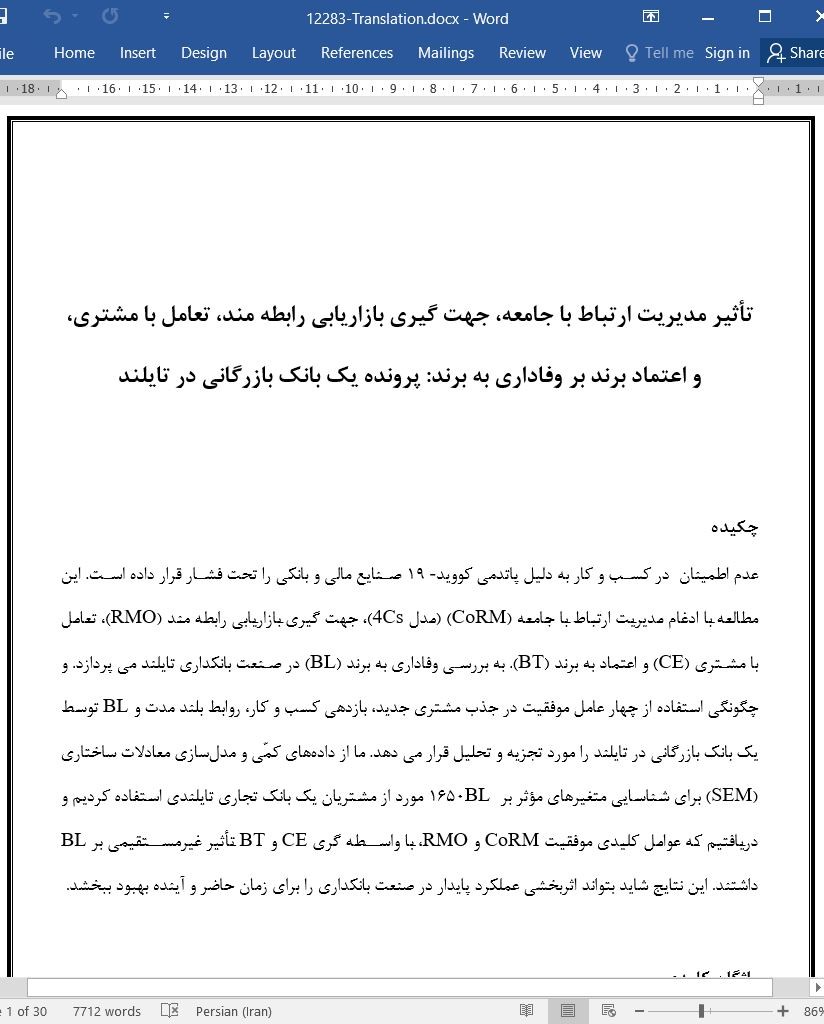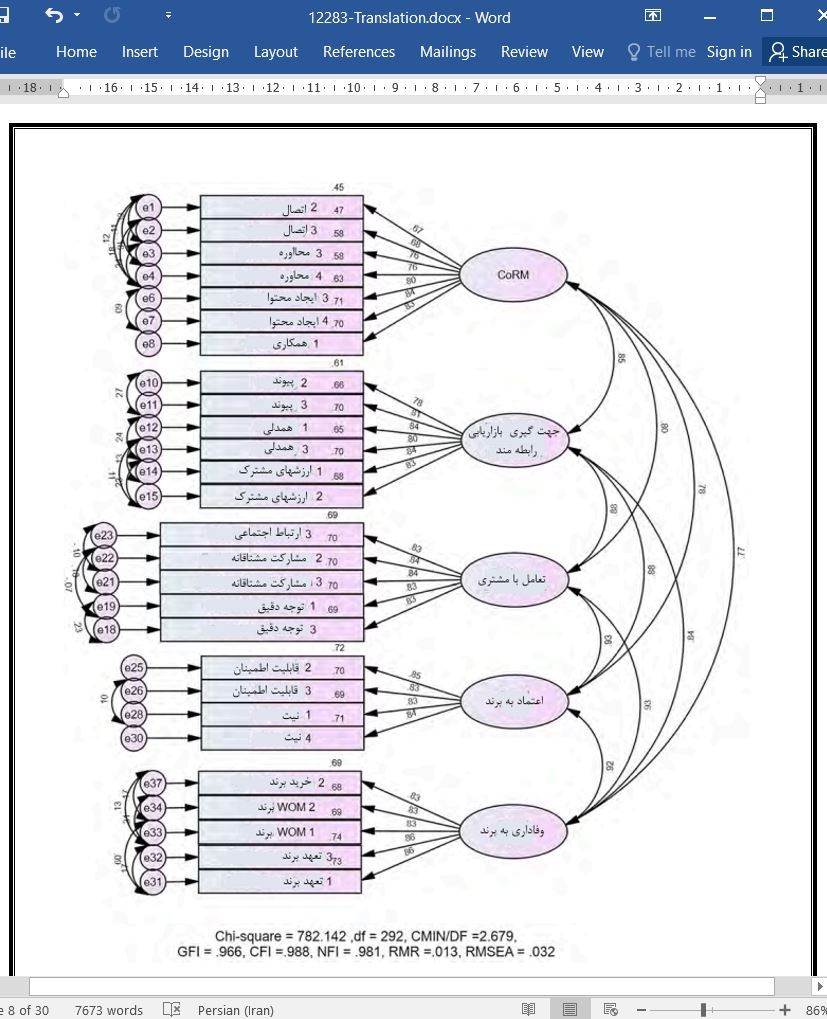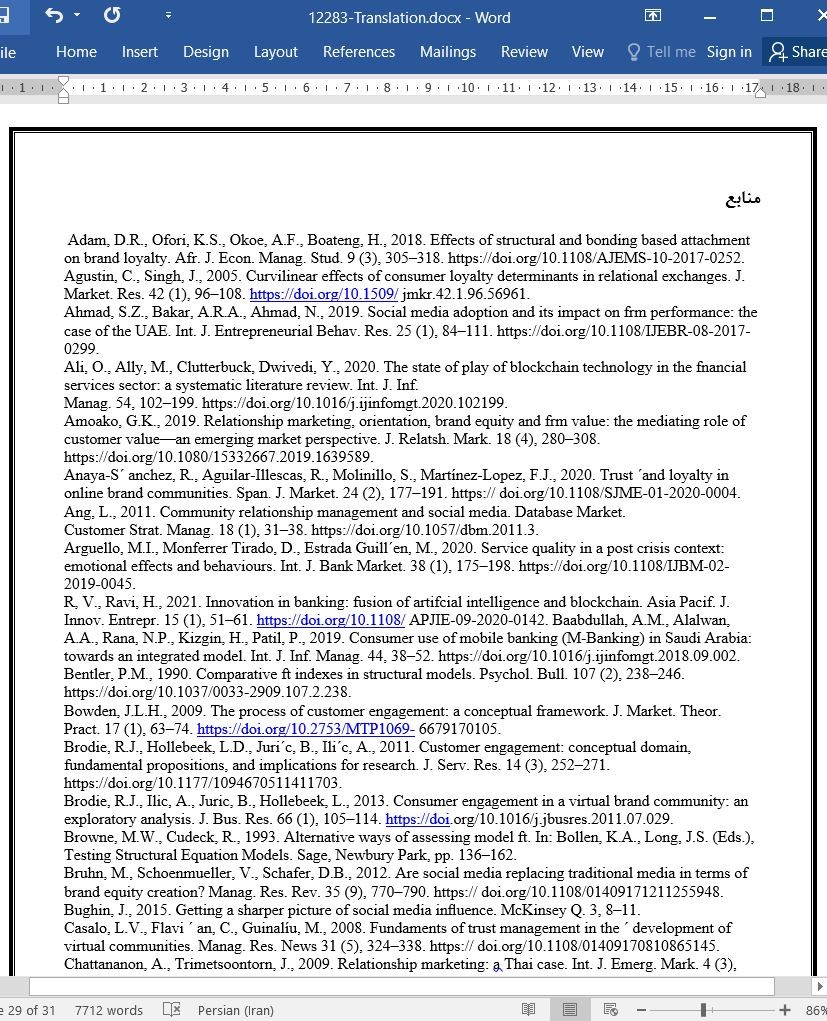
تأثیر مدیریت ارتباط با جامعه، جهت گیری بازاریابی رابطه مند، تعامل با مشتری، و اعتماد برند بر وفاداری به برند
چکیده
عدم اطمینان در کسب و کار به دلیل پاتدمی کووید- 19 صنایع مالی و بانکی را تحت فشار قرار داده است. این مطالعه با ادغام مدیریت ارتباط با جامعه (CoRM) (مدل 4Cs)، جهت گیری بازاریابی رابطه مند (RMO)، تعامل با مشتری (CE) و اعتماد به برند (BT). به بررسی وفاداری به برند (BL) در صنعت بانکداری تایلند می پردازد. و چگونگی استفاده از چهار عامل موفقیت در جذب مشتری جدید، بازدهی کسب و کار، روابط بلند مدت و BL توسط یک بانک بازرگانی در تایلند را مورد تجزیه و تحلیل قرار می دهد. ما از دادههای کمّی و مدلسازی معادلات ساختاری (SEM) برای شناسایی متغیرهای مؤثر بر BL 1650 مورد از مشتریان یک بانک تجاری تایلندی استفاده کردیم و دریافتیم که عوامل کلیدی موفقیت CoRM و RMO، با واسطه گری CE و BT تأثیر غیرمستقیمی بر BL داشتند. این نتایج شاید بتواند اثربخشی عملکرد پایدار در صنعت بانکداری را برای زمان حاضر و آینده بهبود ببخشد.
1. مقدمه
یکی از مهم ترین انقلاب های بازار محور در بخش مالی و بانکداری، فن آوری مالی است که محیط متنوع تری را برای خدمات مالی منحصر به فرد فراهم می کند. «استارت آپ های فین تک، توسعه دهندگان فن اوری، دولت ها، مشتریان مالی و موسسات مالی سنتی از عواملی هستند که به نوآوری در صنعت مالی که با تغییرات قابل توجهی در خدمات مالی سنتی مواجه است کمک می کنند (Sardianou و همکاران، 2021؛ ص 1784؛ Lee و Shin، 2018). بیش از دو میلیارد نفر در اقتصادهای نوظهور به خدمات بانکداری سنتی محدود شده اند، و کارآفرینان بلاک چین با ارائه راه حلهای جدید برای تبادل ارزش، شروع به بررسی این مشکل کرده اند (Frizzo-Barker و همکاران، 2020؛ Larios-Hern´ andez، 2017).
6.3. محدودیتها و تحقیقات آتی
استفاده صرفا از داده های کمّی، از محدودیت های این مطالعه است. محدودیتهای دیگر، به صنعت (بانکداری)، منطقه (تایلند) و حجم نمونه (زنان، 18 تا 29 ساله، و نسبت بخش خدمات) مرتبط است. بنابراین، این نتایج ممکن است برای سایر صنایع و کشورهای دیگر قابل اجرا نباشد. مطالعات آینده باید از داده های کیفی برای بررسی ارتباط بین CoRM، RMO، CE، BT و BL استفاده کنند و اکتشاف خود را به صنایع غیرمشابه و کشورهای دیگر با نمونه و مدل متعادلتر گسترش دهند.
Abstract
Business uncertainty due to the COVID-19 pandemic has brought financial and banking industries under stress. This study examines brand loyalty (BL) in the Thai banking industry by integrating community relationship management (CoRM) (4Cs model), relationship marketing orientation (RMO), customer engagement (CE), and brand trust (BT). It analyzes how a Thai commercial bank used four success factors to create new client acquisition, business efficiency, long-term relationships, and BL. We use quantitative data and structural equation modeling (SEM) to identify variables influencing the BL of 1650 customers of a Thai commercial bank. We found CoRM and RMO's key success factors indirectly affected BL by mediating CE and BT. These results may improve sustained performance effectiveness in the banking industry now and in the future.
1. Introduction
One of the most significant market-driven revolutions in the financial and banking sector is financial technology providing a more varied environment for unique financial services. “Fintech startups, technology developers, governments, financial customers, and traditional financial institutions are elements that contribute to an innovative financial industry, which is facing significant changes in traditional financial services” (Sardianou et al., 2021, p. 1784; Lee and Shin, 2018). Over two billion people in emerging economies have been limited to traditional banking services, and blockchain entrepreneurs are starting to address this issue with new solutions for value exchange (Frizzo-Barker et al., 2020; Larios-Hern´ andez, 2017).
6.3. Limitations and further research
The sole use of quantitative data is a limitation of the study. Additional limitations relate to the industry (banking), region (Thailand), and sample size (females, aged 18–29, and the service sector proportion). Thus, the results may not be applicable to other industries and countries. Future studies should utilize qualitative data to examine associations among CoRM, RMO, CE, BT, and BL and extend their exploration to dissimilar industries and other countries, with a more balanced sample and model.
چکیده
1. مقدمه
2. مروری بر مقالات
2.1. مدیریت ارتباط با جامعه
2.1.1. اتصال
2.1.2. محاوره
2.1.3. ایجاد محتوا
2.1.4. همکاری
2.1.5. جوامع آنلاین
2.2. جهت گیری بازاریابی رابطه مند
2.3. تعامل مشتری
2.4. اعتماد به برند
2.5. وفاداری به برند
3. روش تحقیق
3.1. طرح پیمایشی
3.2. جمع آوری داده ها
3.3. روایی و پایایی
3.4. مدلهای اندازه گیری و ساختاری
4. نتایج
5. بحث
6. مفاهیم
6.1. مفاهیم نظری
6.2. مفاهیم مدیریتی
6.3. محدودیتها و تحقیقات آتی
منابع
Abstract
Abbreviations
1. Introduction
2. Literature review
2.1. Community relationship management
2.1.1. Connectivity
2.1.2. Conversations
2.1.3. Content creation
2.1.4. Collaboration
2.1.5. Online communities
2.2. Relationship marketing orientation
2.3. Customer engagement
2.4. Brand trust
2.5. Brand loyalty
3. Research method
3.1. Survey design
3.2. Data collection
3.3. Reliability and validity
3.4. Measurement and structural models
4. Results
5. Discussion
6. Implications
6.1. Theoretical implications
6.2. Managerial implications
6.3. Limitations and further research
Acknowledgements
References
- اصل مقاله انگلیسی با فرمت ورد (word) با قابلیت ویرایش
- ترجمه فارسی مقاله با فرمت ورد (word) با قابلیت ویرایش، بدون آرم سایت ای ترجمه
- ترجمه فارسی مقاله با فرمت pdf، بدون آرم سایت ای ترجمه



